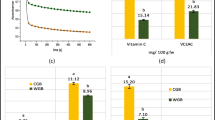Abstract
This study was conducted to evaluate the total carotene content (TCC) and beta carotene (BC) in the selected underutilized tropical fruits. TCC of underutilized fruits estimated by spectrophotometric method was in the range of 1.4–19.8 mg/100 g edible portion. The TCC of these fruits decreased in the order: Jentik-jentik > Durian Nyekak 2 > Durian Nyekak 1 > Cerapu 2 > Cerapu 1 > Tampoi Kuning > Bacang 1 > Kuini > Jambu Mawar > Bacang 2 > Durian Daun > Bacang 3 > Tampoi Putih > Jambu Susu. BC contents estimated by HPLC method were highest in Jentik-jentik, followed by Cerapu 2, Durian Nyekak 2, Tampoi Kuning, Durian Nyekak 1, and Cerapu 1, which had a range of 68–92% of BC in TCC. These underutilized fruits have an acceptable amount of carotenoids that are potential antioxidant fruits.

Similar content being viewed by others
References
Burns J, Fraser PD, Bramley PM (2003) Identification and quantification of carotenoids, tocopherols and chlorophylls in commonly consumed fruits and vegetables. Phytochem 62:939–947 doi:10.1016/S0031-9422(02)00710-0
Hughes DA (2001) Dietary carotenoids and human immune function. Nutr 17:823–827 doi:10.1016/S0899-9007(01)00638-4
Hulshof PJM, Kosmeijer-Schuila T, Westa CE, Hollman PCH (2007) Quick screening of maize kernels for provitamin A content. J Food Compost Anal 20:655–661 doi:10.1016/j.jfca.2006.04.014
Lee CY, Simpson KL, Gerber L (1989) Vegetables as a major vitamin A source in our diet. New York’s Food and Life Sciences Bulletin, 126th edn. New York State Agricultural Experiment Station, Geneva, pp 1–10
Choi Y, Jeong H-S, Lee J (2007) Antioxidant activity of methanolic extracts from some grains consumed in Korea. Food Chem 103:130–138 doi:10.1016/j.foodchem.2006.08.004
Singh J, Upadhyay AK, Prasad K, Bahadur A, Rai M (2007) Variability of carotenes, vitamin C, E and phenolics in Brassica vegetables. J Food Compost Anal 20:106–112 doi:10.1016/j.jfca.2006.08.002
Wilberg VC, Rodriguez-Amaya DB (1995) HPLC quantitation of major carotenoids of fresh and processed guava, mango and papaya. Lebenson Wiss Technol 28:474–480 doi:10.1006/fstl.1995.0080
Peng Y, Ma C, Li YW, Leung KS-Y, Jiang ZH, Zhao ZZ (2005) Quantification of zeaxanthin dipalmitate and total carotenoids in Lycium fruits (Fructus Lycii). Plant Foods Hum Nutr 60:161–164 doi:10.1007/s11130-005-9550-5
Bioversity International (2004) Banana researchers gather in Malaysia, hoping to change lives. News Item Press Releases, News Archive for July 2004. http://www.bioversityinternational.org/news_and_events/news/news_archives/. Accessed: April, 2005.
Lako J, Trenerry VC, Wahlqvist M, Wattanapenpaiboon N, Sotheeswaran S, Premier R (2007) Phytochemical flavonols, carotenoids and the antioxidant properties of a wide selection of Fijian fruit, vegetables and other readily available foods. Food Chem 101:1727–1741 doi:10.1016/j.foodchem.2006.01.031
Tee E-S, Lim C-L (1991a) Carotenoid composition and content of Malaysian vegetables and fruits by the AOAC and HPLC methods. Food Chem 41:309–339 doi:10.1016/0308-8146(91)90057-U
Seo JS, Burri BJ, Quan Z, Neidlinger TR (2005) Extraction and chromatography of carotenoids from pumpkin. J Chromatogr A 1073:371–375 doi:10.1016/j.chroma.2004.10.044
Su Q, Rowley KG, O’Dea K (1999) Stability of individual carotenoids, retinol and tocopherols in human plasma during exposure to light and after extraction. J Chromatogr B Analyt Technol Biomed Life Sci 729:191–198 doi:10.1016/S0378-4347(99)00162-0
Prache S, Priolo A, Grolier P (2003) Persistence of carotenoid pigments in the blood of concentrate-finished grazing sheep: its significance for the traceability of grass-feeding. J Anim Sci 81:360–367
Tee E-S, Lim C-L (1991b) The analysis of carotenoids and retinoids: a review. Food Chem 41:147–193 doi:10.1016/0308-8146(91)90042-M
Hart DJ, Scott KJ (1995) Development and evaluation of an HPLC method for the analysis of carotenoids in foods, and the measurement of the carotenoid content of vegetables and fruits commonly consumed in the UK. Food Chem 54:101–111 doi:10.1016/0308-8146(95)92669-B
AOAC (1993) Manual on policies and procedures. Peer Verified Methods Program. Association of Official Analytical Chemists, Arlington, VA, USA
Negi PS, Roy SK (2004) Changes in β-carotene and ascorbic acid content of fresh amaranth and fenugreek leaves during storage by low cost technique. Plant Foods Hum Nutr 58:225–230 doi:10.1023/B:QUAL.0000040361.85578.b5
Correa NM, Durantini EN, Silber JJ (2001) Substituent effects on binding constants of carotenoids to n-heptane/AOT reverse micelles. J Colloid Interface Sci 240:573–580 doi:10.1006/jcis.2001.7640
Lin CH, Chen BH (2005) Stability of carotenoids in tomato juice during storage. Food Chem 90:837–846 doi:10.1016/j.foodchem.2004.05.031
Chen HE, Peng HY, Chen BH (1996) Stability of carotenoids and vitamin A during storage of carrot juice. Food Chem 57:497–503 doi:10.1016/S0308-8146(96)00008-8
Zhang YX, Simonne RDPE, Landen WO Jr, Eitenmiller RR (1998) Stabilization of all-trans beta carotene in raw, minced sweet potato. IFT'S Annual Meeting: Fruits and Vegetables Poster Session II, Atlanta, Georgia, June 22, pp 34B–38
Ben-Amotz A, Fishler R (1998) Analysis of carotenoids with emphasis on 9-cis β-carotene in vegetables and fruits commonly consumed in Israel. Food Chem 62:515–520 doi:10.1016/S0308-8146(97)00196-9
Ajila CM, Bhat SG, Prasada Rao UJS (2007) Valuable components of raw and ripe peels from two Indian mango varieties. Food Chem 102:1006–1011 doi:10.1016/j.foodchem.2006.06.036
Rajyalakshmi P, Padmavathi TVN, Venkata Laxmi K (2003) Total carotenoid and beta carotene contents of other vegetables, roots and tubers, fruits and stored products collected from forest areas of Andhra Pradesh, South India. Plant Foods Hum Nutr 58:1–11
Author information
Authors and Affiliations
Corresponding author
Rights and permissions
About this article
Cite this article
Khoo, H.E., Ismail, A., Mohd-Esa, N. et al. Carotenoid Content of Underutilized Tropical Fruits. Plant Foods Hum Nutr 63, 170–175 (2008). https://doi.org/10.1007/s11130-008-0090-z
Published:
Issue Date:
DOI: https://doi.org/10.1007/s11130-008-0090-z




